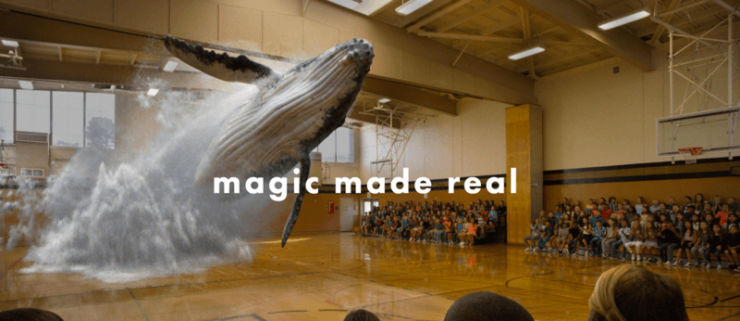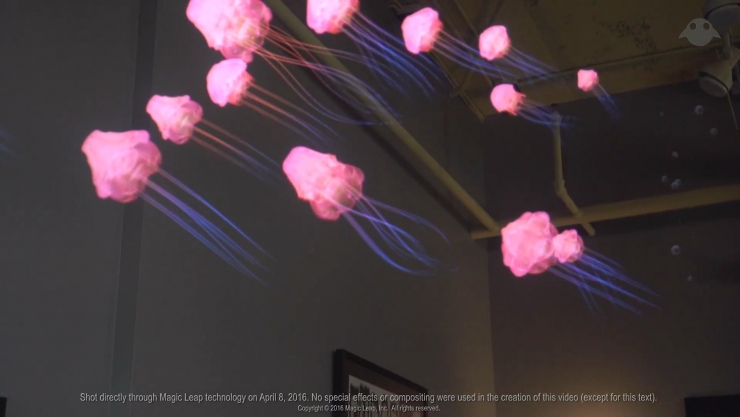For tech companies, the patent application seems to suggest a certain direction of development. In the past 7 years, Microsoft applied for the most AR patents, far more than other companies that developed AR products such as Samsung, Sony, Google and Magic Leap. However, in 2015, Magic Leap’s patent applications increased significantly, while other companies had a noticeable drop. This seems to be echoing Magic Leap’s thunder.
Overall, the number of projects for which technology companies apply for AR patents has increased significantly, which means that in the coming years, we may see iterative updates of AR products. For example, Microsoft is a more prominent case. They have already started selling the $3,000 HoloLens this year.
How many patents have they applied for in the past 7 years? 
The patent application data above is from Envision IP. They mainly focus on patent analysis and approval. (The data for 2015 is not complete because the patent application needs to wait until 18 months after the company submitted the application to disclose it to the outside world.)
Between 2009 and 2015, Microsoft applied for more than 600 AR patents, but in 2012, it had 164 patent applications. This was followed by Samsung. In the same period, they applied for 374 patents, while Sony was slightly less. At the same time, Google applied for 230 items, 177 for Maigc Leap and 166 for Apple. Also active in the AR patent application is the American startup Ostherout Design Group, which applied for 122 patents in 2013 and was ranked fourth at the time.
At the same time, Magic Leap’s patent application last year was a substantial increase. It is clear from the chart that compared with other companies, the company had very few patent applications from 2009 to 2014, and the number of applications in 2015 alone reached 164 . Although we are still seeing some amazing video presentations, we can't stop investors from paying too much attention to them. Maulin Shah, a managing lawyer at Envision IP, said, "Perhaps they have been optimizing their own technology and IP strategy before filing a large number of patent applications."
However, Facebook has only applied for 37 AR patents in the past 7 years.
Magic Leap really only video?In addition to patent applications attracting attention, Magic Leap has also issued heavy news in financing. In February of this year, Magic Leap received a Series C financing of $793.5 million from Alibaba. In August, she quietly set up a new team in Austin, Texas. But what to do is still a mystery. Not long ago, this company was again invested by Yinjiang.
In retrospect, every major news about Magic Leap seems to be inseparable from the video. In March 2015, the company announced a video related to its product. Although the video did not show the specific form of the product, it demonstrated the features it could perform. In the office, users can see virtual images, operate shooting games, send and receive emails, and perform some gestures.
In October, a big whale in the stadium was swept up in a circle of friends. The video scene is like a gymnasium in the school. A huge whale drowning from the ground rises and then falls. The gym seems to be turning into the ocean. However, it was later reported by some media that this and the above indoor shooting games are special effects.

The latest video, "A New Morning," was released in April this year. In the video, a small word was added stating "In addition to text, there are no video effects or editing methods." In this video, we can see that the smart phone notification appears at the top of the table, you can click on the message notifications, emails, view data reports, etc. You can also open the shopping website for shopping or make the room full of jellyfish. This video is a real shot of Real Valley rendering.
Obviously, there is no product only magic Leap out of the video, every time people let people have a new understanding of AR, but also let the outside world continue to speculate about its technology. Even so, they are still applying for more patents, company founder Rony Abovitz only revealed that the virtual elements projected from the light source on the edge of the device, and use the spectral nano-ridges reflected into the user's eyes.

Lei Fengnet (search "Lei Feng network" public concern) previously published articles that, Magic Leap killer is the use of optical fiber to the retina directly into the entire digital light field produced by Cinematic Reality (film-level reality), it can make people's eyes auto focus . They said that they can create soft and hard kits that have the effects of Cinematic Reality. When the human eye adjusts the focus, the angle and depth of the light field will be converted, and the effect is comparable to the light field camera.
The biggest difference between Magic Leap and HoloLens is the display part, which uses a semi-transparent glass and projects the reality from the side DLP. The virtual object is always real, similar to the Google Glass solution.
Patent may not be enough to explain everythingOf course, the application for new patents is just a way to judge the internal development direction of the company, and it cannot fully explain their specific development plans.
From another perspective, this patent application data shows how much time interval a company proposes the invention concept until the product is released. Take Microsoft, from 2010 to 2100, their application for AR patents increased from 68 to 110. By 2015, Microsoft has finally announced the Holloens, a holographic display developed by the company. Users can see the holographic images projected in the real world after they put on their heads.
Undoubtedly, HoloLens is the most advanced consumer-grade product with a new type of lens called a "diffraction element." This lens can use built-in fiber optic components to reflect images to the user's eyes. As a result, all augmented reality glasses similar to HoloLens use diffractive element lenses, or very similar lenses.
In contrast, Magic Leap has not announced any physical products so far.
It is undeniable that the patent application does also predict the development of various companies, such as Sony and Google will be involved in the field of augmented reality. Google had AR patent applications in 2011, and three years ago, they released Google Glass and sold them to the public. In the past, Sony has been studying augmented reality. After a series of patent applications, they recently released a prototype device. One of Samsung's patent applications is a contact lens that can transform the real world into a 3D canvas.
For Magic Leap, patents and funds are basically in place, and perhaps the product fan will soon be unlocked.
Our factory can produce the galvanized steel poles with various heights.
Steel Lighting Pole,Steel Lamp Post,Metal Lamp Post,Metal Pole For Outdoor Lights
Jiangsu Baojuhe Science and Technology Co.,Ltd. , https://www.galvanizedsteelpole.com